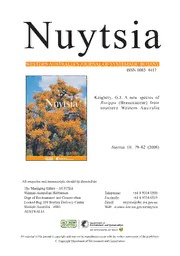
A new species of Rorippa (Brassicaceae) from southern Western Australia PDF
Preview A new species of Rorippa (Brassicaceae) from southern Western Australia
N u y t s i a WESTERN AUSTRALIA'S JOURNAL OF SYSTEMATIC BOTANY ISSN 0085–4417 Keighery, G.J. A new species of Rorippa (Brassicaceae) from southern Western Australia Nuytsia 18: 79–82 (2008) All enquiries and manuscripts should be directed to: The Managing Editor – NUYTSIA Western Australian Herbarium Telephone: +61 8 9334 0500 Dept of Environment and Conservation Facsimile: +61 8 9334 0515 Locked Bag 104 Bentley Delivery Centre Email: [email protected] Western Australia 6983 Web: science.dec.wa.gov.au/nuytsia AUSTRALIA All material in this journal is copyright and may not be reproduced except with the written permission of the publishers. © Copyright Department of Environment and Conservation NGu.Jy.t Ksiaei g1h8e(1ry):, A79 n–e8w2 (s2p0e0ci8e)s of Rorippa 79 A new species of Rorippa (Brassicaceae) from southern Western Australia Greg J. Keighery Department of Environment and Conservation, Wildlife Research Centre, PO Box 51, Wanneroo, Western Australia 6065 Abstract Keighery, G.J. A new species of Rorippa (Brassicaceae) from southern Western Australia. Nuytsia 18(1): 79–82 (2008). The Western Australian populations of Rorippa dictyosperma (Hook.) L.A.S.Johnson are segregated as a new species, R. cygnorum Keighery sp. nov. Introduction This paper is one of a continuing series on the taxonomy of the native and naturalised Brassicaceae of Western Australia. Rorippa Scop. (Brassicaceae) is closely related to Cardamine L., Aradidopsis Heyne and Nasturtium W.T.Aiton. The last genus is often included in a broadly defined Rorippa. In this sense Rorippa is a cosmopolitan genus of approximately 75 species and has four endemic and three introduced species in Australia (Johnson 1962; Hewson 1982). There are three species recorded for Western Australia, two native and one introduced. The sole native species of Rorippa currently recorded for southern Western Australia, R. dictyosperma (Hook.) L.A.S.Johnson, also occurs in New South Wales, Victoria and Tasmania (Hewson 1982). The type collection of Rorippa dictyosperma is from Tasmania, viz. R.C. Gunn 80, 401 (K, photo seen). The Western Australian form of Rorippa dictyosperma differs from Eastern Australian populations in being an annual, with shorter, thicker pedicels (4–8 vs 10–20 mm), a much shorter style (2 vs. 4 mm) and much finer reticulation on the seed. Hewson (1982) and Johnson (1962 and in litt.) suggested that the Western Australian populations should be recognised as a separate taxon, but did not formalise this separation. These character differences warrant taxonomic recognition and the Western populations are described here as a new species, R. cygnorum Keighery. Taxonomy Rorippa cygnorum Keighery, sp. nov. Rorippa dictyospermae affinis sed habitu annuo, stylo brevi vel brevissimo, pedicello crasso brevi, testa subtiliter reticulata differt. 80 Nuytsia Vol. 18 (2008) Typus: Porongurup Range [precise locality withheld for conservation reasons], 3 December 1988, G.J. Keighery 10416 (holo: PERTH 4400208; iso: CANB, K). Erect annual herb, 30–90 cm tall, rarely decumbent. Leaves petiolate; basal leaves pinnatisect, to 20 cm long, with large terminal lobe, the lateral segments few, ovate or oblong, entire or toothed, stem leaves reducing to lanceolate, entire, petiolate. Sepals 2.5–5 mm long, petals 5–10 mm long, white. Stamens 6, style 2 mm long. Siliqua straight or slightly curved, 25–60 mm long, 1–2 mm wide ascending; pedicel spreading to reflexed, 4–8 mm long; seeds in one row per loculus, not mucilagenous when wet, very finely reticulate, ovoid to oblong, 1–2 mm long. (Figure 1) B A Figure 1. Rorippa cygnorum (both from B. & G. Keighery 1122). A – whole plant; B – flower with half floral parts removed to show anthers and style. Scale bars: A = 20 mm; B = 2 mm. G.J. Keighery, A new species of Rorippa 81 Selected specimens examined. WESTERN AUSTRALIA: [localities withheld] 29 Nov. 1990, A.R. Annels 1399 (PERTH); 30 Nov. 1994, A.R. Annels & R.W. Hearn 5066 (PERTH); [without locality], s.dat., J. Drummond 94 (MEL); 14 Jan. 1989, G.J. Keighery 11945 (PERTH); 1 Nov. 2007, G. & B. Keighery 1122 (PERTH); 26 Aug. 1997, K.A. Redwood 586 (PERTH); Oct. 1867, F. von Mueller (MEL 93091); s. dat., P. Walcott s.n. (MEL). Distribution. Recorded in a series of disjunct populations from the Porongurup Range to north of Walpole in the Jarrah Forest and Warren biogeographic regions (Figure 2). Habitat. Occurs on moss swards on granite rocks or along seepage lines below granites, the latter in the eastern part of the range (e.g. Porongurup Range), especially after summer fires. In eastern Australia, the related Rorippa dictyosperma occurs in forests and woodlands from the coast to subalpine areas (Entwisle 1996). Flowering period. Flowers in late spring to early summer, from late November to January. Mature fruits and seeds are present from December to February. Figure 2. Distribution of Rorippa cygnorum in southern Western Australia. 82 Nuytsia Vol. 18 (2008) Conservation status. Listed as Priority Two under Department of Environment and Conservation (DEC) Conservation Codes for Western Australian Flora by Atkins (2008) under the name R. dictyosperma. Etymology. From the Latin cygnus (swan), in reference to the original name for Perth, the Swan River Colony. Notes. The common name for Rorippa dictyosperma in Eastern Australia is Forest Bitter Cress, the name Western Bitter Cress is suggested for this species. Acknowledgements The author was able to examine type material of Rorippa dictyosperma, and other collections at MEL with the assistance of the former Curator of Melbourne Herbarium, Jim Ross. Thanks are also due to the other bodies (Environment Australia (now Department of Environment and Herritage) and the Australian Heritage Commission) who funded the many biological surveys noted herein. References Atkins, K.J. (2008). Declared Rare and Priority Flora List for Western Australia. (Department of Environment and Conservation: Kensington, W.A.) Hewson, H.J. (1982). Rorippa. In: Flora of Australia. Vol. 8, pp. 322–336 (Australian Government Publishing Service: Canberra.) Entwisle, T.J. (1996). Brassicaceae. In: Walsh, N.G. & Entwisle, T.J. (eds) Flora of Victoria. Vol. 3, pp. 299–459 (Inkata Press: Melbourne.) Johnson, L.A.S. (1962). Taxonomic notes on Australian plants. Contributions from the New South Wales National Herbarium 3(3): 93–102.
